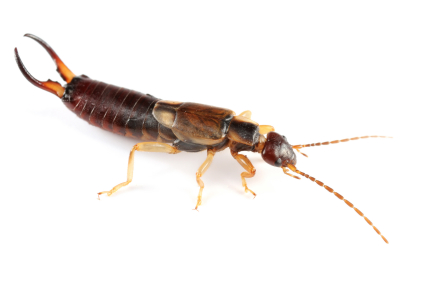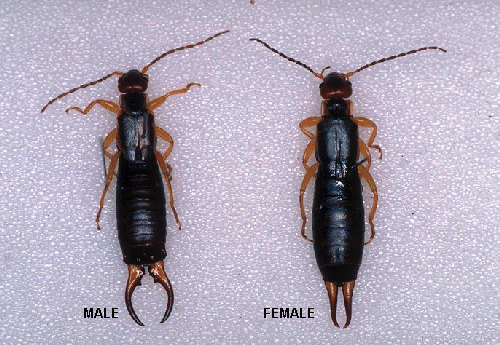Earwigs
 Earwigs
are elongated, flattened insects, that may be light
red-brown to black in color. They are easily
recognized by their forceps-like appendages on the
end of the abdomen. The size and shape vary between
species and between males and females. These insects
have chewing mouthparts and long, slender antennae
and are either winged or wingless. If wings are
present, the first pair are hard and very short,
barely covering the first segments of the insect's
abdomen. There are two common species of earwigs
found in North Carolina. The European earwig is
about 1/2
to 3/4
inch long, with banded legs and reddish head. The
ringlegged earwig ranges from
1/2
to 3/5
inch long and is black-yellowish underneath
with legs having dark crossbands. Young earwigs
(nymphs) are similar to adults and will have a white
to olive-green appearance and do not have wings.
Earwigs
are elongated, flattened insects, that may be light
red-brown to black in color. They are easily
recognized by their forceps-like appendages on the
end of the abdomen. The size and shape vary between
species and between males and females. These insects
have chewing mouthparts and long, slender antennae
and are either winged or wingless. If wings are
present, the first pair are hard and very short,
barely covering the first segments of the insect's
abdomen. There are two common species of earwigs
found in North Carolina. The European earwig is
about 1/2
to 3/4
inch long, with banded legs and reddish head. The
ringlegged earwig ranges from
1/2
to 3/5
inch long and is black-yellowish underneath
with legs having dark crossbands. Young earwigs
(nymphs) are similar to adults and will have a white
to olive-green appearance and do not have wings.
Life Cycle and Habits
 Earwigs
get their name from a European superstition that
these insects enter the ears of a sleeping person
and bore into the brain. During the spring or
autumn, the female earwig lays 20 to 50 smooth,
oval, white or cream-colored eggs in a chamber in
the upper 2-3 inches of soil. Earwigs are somewhat
unusual (among insects) in that the female cares for
the eggs and for newly hatched nymphs (immatures)
until they molt for the first time. The nymphs leave
the nest and spend one season maturing. Both eggs
and adults overwinter in the soil below the
frostline to escape the cold temperatures.
Earwigs
get their name from a European superstition that
these insects enter the ears of a sleeping person
and bore into the brain. During the spring or
autumn, the female earwig lays 20 to 50 smooth,
oval, white or cream-colored eggs in a chamber in
the upper 2-3 inches of soil. Earwigs are somewhat
unusual (among insects) in that the female cares for
the eggs and for newly hatched nymphs (immatures)
until they molt for the first time. The nymphs leave
the nest and spend one season maturing. Both eggs
and adults overwinter in the soil below the
frostline to escape the cold temperatures.
Earwigs rarely fly and can move about readily but
often hitchhike in laundry baskets, cut flowers,
luggage, newspapers, carboard boxes, lumber, baskets
of fruits and vegetables, automobiles, etc. They
require moist, cool places and are usually found in
damp crawl spaces or basements, flower gardens near
the home, in mulches, compost piles, trash, under
boards and in wood piles. During dry, hot weather,
earwigs sometimes migrate indoors. They are active
primarily at night and are often found around
lights. They feed on mosses, lichens, algae, fungi,
insects, spiders and mites, both dead and alive.
Some earwigs are predators, feeding on aphids, while
others feed on living plants and may become pests in
greenhouses and on certain crops such as vegetables,
fruits, ornamentals, forages and field plants.
